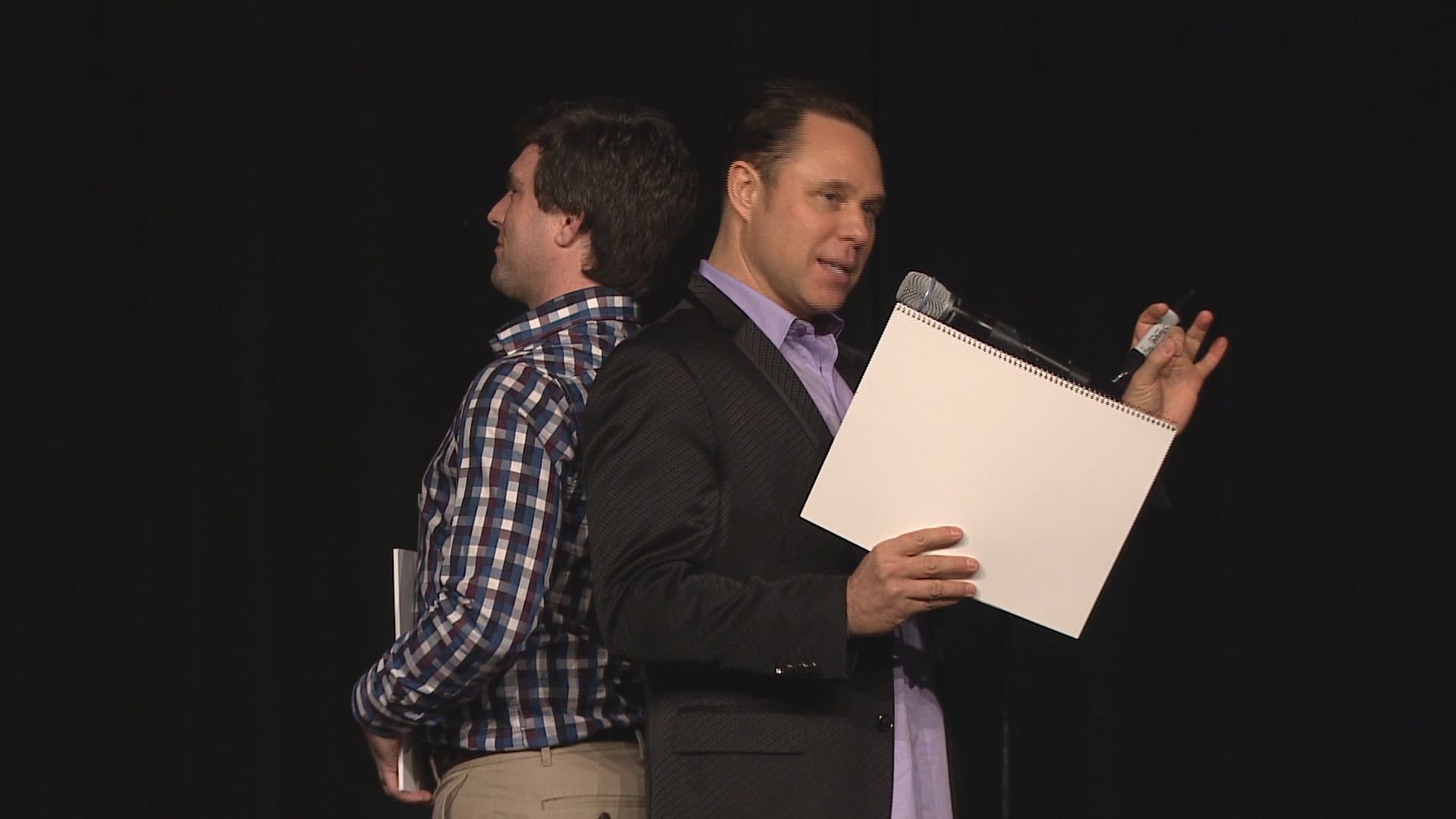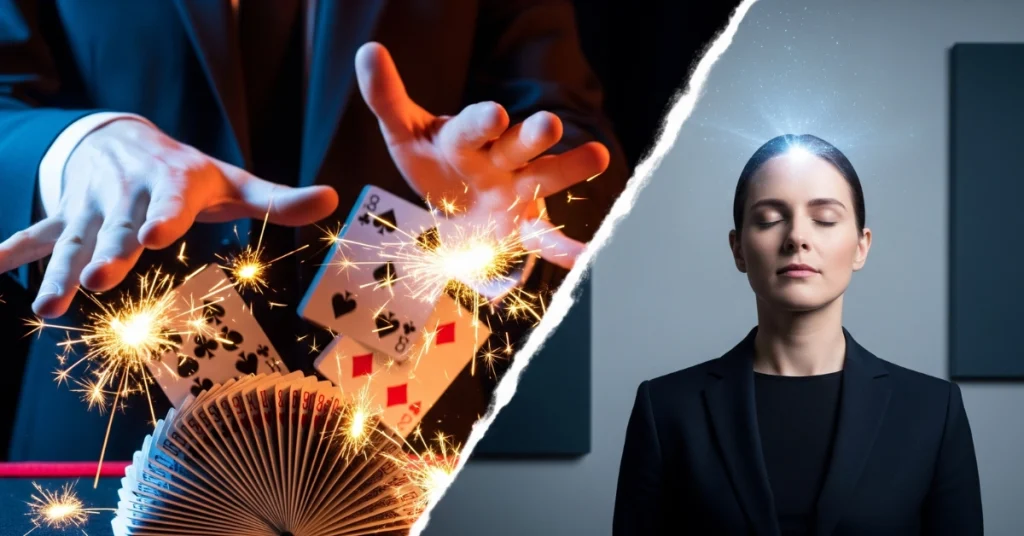On behalf of Randy Charach, a mentalist and magician. In this article, I will share everything about mentalism. The art behind mentalism, how mentalists make it work, its history, how it differs from magic, a few amazing tricks, and much more.
So, let’s explore this fascinating art form, which has mesmerized audiences for centuries.

What is Mentalism?
Mentalism is a performing art where the performers read minds, predict the future, and influence your thoughts. It’s magic for your brain instead of your eyes. Mentalists make use of psychology, body language reading, and smart techniques to create experiences that you can’t imagine.
Unlike typical magic shows with flashy props and stage illusions, Mentalism focuses more on mental tricks. It’s all about creating experiences that make you in awe: “How did they know that?”
This creative art form gained immense popularity thanks to TV shows like “The Mentalist” and popular entertainers who made mind-reading appear authentic. However, here’s the secret – it’s all skillful performance, not real psychic abilities.
What is a Mentalist?
A mentalist is a performer or an entertainer who is an expert in creating the illusion of supernatural mental powers. They are like detectives of human psychology, studying and observing how people think, move, and react.

Types of Mentalists
There are three main types of mentalists:
1. Magicians: These entertainers utilize Mentalism as part of their act, combining mind-reading with sleight of hand, props, and some pre-planned tricks. It’s a performance that can often use secret assistants from the audience and clever setups to create an illusion of unimaginable moments.
2. Psychics and Tarot Card Readers: Some witty people claim to have real supernatural or paranormal abilities. But, skeptics believe they are skilled mentalists using clever techniques like “cold reading” – observing your reactions to make accurate-seeming speculations.
3. Performing Mentalists: These are the modern or professional mentalists you watch on TV talent shows or in theaters. They focus solely on mental feats like guessing numbers, reading minds, or influencing thoughts. They are clear about being entertainers, not claiming to have actual psychic powers.
How Do Mentalists Work? How They”Read” Your Mind?
Mentalists don’t actually read minds; they are experts at reading YOU. Our minds are super powerful but surprisingly easy to trick. Mentalists use this to trick you.
Let’s think about “The Dress” debate from 2015, where people saw different colors in the same photo. This clearly proves how our brains can be fooled by what we expect to see.
Mentalists understand and use the following psychological tricks:
- The Placebo Effect: People feel good after taking fake medicine because they believe that the medicine works.
- Frequency Illusion: When someone learns a new word, they suddenly see it everywhere. Their brain just pays more attention to those familiar/special things.
- Confirmation Bias: We usually only look for the information that proves what we already believe.
Mentalists combine the above mental shortcuts with technical skills and showmanship to create mind-blowing performances.
The Difference Between Magic and Mentalism
While magic and Mentalism might look the same, they’re actually quite different. Let’s see how!

| Key Differences | Typical Magic | Mentalism |
|---|---|---|
| Focus | Visual feats and physical illusions | Mental experiences with psychological effects |
| Props | Often use props like cards, boxes, and rabbits | Minimal or no props usage; often just the mentalist’s conversation |
| Style of Performance | Emphasizes “impossible” visual tricks | Explores thoughts, speculations, and mind-reading |
| Viewer Perception | The audience knows it’s a performance and enjoys the illusion | Can make audiences question what’s real |
| Techniques | Sleight of hand and misdirection | Suggestion, influence, cold reading, body language cues |
| Underlying Themes | Surprise, awe, and visual spectacle | Psychology, intuition, observation, and behavioral analysis |
Certain Mentalists perform “prop-less Mentalism”. As they do their complete act through conversation alone. This makes their performances feel more real and personal than the typical magic performances.
The key point is that Magic tricks your eyes, while Mentalism feats your brain.
A Brief History of Mentalism
Mentalism has some roots in history. For instance, medieval kings usually called upon senior seers for advice, to predict the future, and to communicate with the dead. These practices were witnessed through ancient Greek texts and biblical stories about oracles and prophets.
- Early Beginnings – 1572: The first ever recorded Mentalism performance was witnessed when magician Girolamo Scotto amused audiences with some amazing mind-reading tricks.
- Gain Popularity – 1800s: Mentalism became increasingly famous with John Randall Brown’s mind-reading feats. Viewers thought he had real supernatural powers, but in reality, he only used “muscle reading” (observing tiny body movements to predict thoughts).
- The Amazing Kreskin Era – 1970s: George Joseph Kresge, widely known as The Amazing Kreskin, became a TV hit. His signature feat involved audience members hiding a check while he was backstage, then returning to find it. He succeeded most of the time but failed on twelve occasions. This proves that mentalists aren’t super-beings!
- Modern Times: Today’s Mentalists entertain audiences in Las Vegas shows and on talent competitions. They are honest about being entertainers, not claiming real psychic or paranormal powers.
Famous Mentalists Throughout History
The world of mentalism has produced many legendary performers:
Uri Geller – The Spoon Bender

Uri Geller gained fame in the 1970s by bending spoons and stopping watches with his “mind” on live television. He claimed to possess genuine psychic powers, and his mystical performances captivated millions around the globe.
Later, he was exposed by the skeptics as using tricks. Geller still played a huge role in mainstreaming Mentalism. Both his popularity and controversy sparked public interest in psychic abilities and mind-reading.
Derren Brown – The Mind Manipulator
Derren Brown is a British mentalist known for blending magic, psychology, and prediction. He creates some amazing stage shows and TV specials that leave the audience in awe.
Though Brown is honest in his creative art of Mentalism, he claims no supernatural abilities. Instead, he uses real psychological techniques to influence the mind and behavior, making his work even more mesmerizing.
George Joseph Kresge – The Amazing Kreskin

The Amazing Kreskin became a TV hit in the 1970s with his mind-reading and prediction tricks. He never claimed to have psychic or paranormal powers, but wowed the audiences with his smart mental skills.
One of his most popular stunts involves finding his hidden paycheck using only his mind. Kreskin helped make Mentalism mainstream on TV and influenced many mentalists who followed.
Max Maven – The Mentalist Legend
Max Maven was famous for his gothic look and mystic stage presence. He used deep psychological knowledge with a theatrical flair that made his performances truly unique.
Beyond the performances, he was known as a respected creator and writer in the Mentalism world. His work carved modern Mentalism, and many entertainers today still use his ideas and techniques.
Theresa Caputo – The Spirit Medium
Theresa Caputo, also known as the Long Island Medium, claims she can talk to the deceased. On her TV show, she gives emotional messages from “the spirits” to people seeking closure.
Skeptics believe that she uses cold-reading Mentalism techniques. Whether real or just some mind-bending methods, her work spreads Mentalism-style readings to a massive mainstream audience.
7 Mind-Blowing Mentalism Tricks You Have to See to Believe
Let’s step into the world of illusion and discover the following seven mind games that leave audiences numb:

1. Cold Reading: This is the key technique of Mentalism. Mentalists make general statements and keenly observe your body language for reactions. For example, if you lean forward when they mention “someone whose name starts with M,” they know they are on the right track. They then build on these reactions to create some seemingly accurate readings.
2. Sleight of Hand: Even Mentalists, like magicians, use quick hand movements to create illusions. But their sleight of hand is more subtle. For instance, they might secretly glance at what you wrote or switch papers without you noticing. It feels like real mind-reading — but it’s all a witty technique.
3. The Power of Suggestion: Mentalists influence ideas in your brain without you realizing it you. For example, they might casually mention “red” several times during their act, making you more likely to think of red when asked to pick a color. You will think it was your choice, but they influenced it.
4. Muscle Reading: This technique involves reading and observing tiny, unconscious body movements. When you think about something, your body provides subtle clues. A skilled mentalist can detect these micro-movements and utilize them to “read” your thoughts.
5. Hot Reading: Some mentalists research their audience in advance. They might check social media profiles or have secret assistants gather information. During the show, they reveal this “discovered” information as if they are reading minds.
6. Force Techniques: Mentalists make you think you have free choice while actually influencing your decision. Like specific mathematical forces, word associations, and psychological principles guide you toward the answer they want.
7. Memory Palace Method: Some professional mentalists demonstrate amazing memory feats by using specific ancient memory techniques. They create mental “palaces” where they store information in specific locations, allowing them to remember incredible amounts of detail.
The Psychology Behind Mentalism
True Mentalism relies on understanding human psychology. Our minds work in predictable ways, and mentalists exploit those patterns.
Pattern Recognition
Humans have a natural tendency to seek order and meaning, even in seemingly random data. Mentalists use this pattern by planting ideas or coincidences that make unrelated events appear connected. In this way, they make their “insights” seem more profound than they are.
Social Compliance
Most people instinctively want to be cooperative and avoid confrontation. By framing questions in a specific way, mentalists influence people to agree or respond predictably, making it seem like the mentalist knew something all along.
Selective Memory
This is another psychological aspect that people tend to remember the moments that confirm their expectations and ignore the rest. Mentalists utilize this by throwing out many statements – only a few need to land for the audience to believe they were consistently accurate.
The Barnum Effect
Vague or generalized statements feel deeply personal when they appear to reflect our individual experiences. Mentalists use emotionally charged and broad phrases that resonate with nearly everyone, giving the illusion of a deep, personal reading.
Understanding and using the above psychological principles is what separates good mentalists from the legends.
How to Spot Mentalism Techniques?
Now that you know the secret Mentalism recipe, here’s how to spot Mentalism in action:

Watch for Leading Questions
Mentalists ask questions that seem simple but provide hints. For instance, “You’re thinking of someone important to you, aren’t you?” sounds general but helps them guess more. It tricks you into providing them information.
Notice Body Language Reading
Mentalists keenly observe your face and body language. They use small clues like how you smile or move to guess what you’re feeling or thinking. It’s like they’re reading your micro-reactions and body movements.
Look for General Statements
Watch out for broad phrases like “I sense a loss” or “You’re going through a change.” These are true for most people, but they feel special when explicitly related to you.
Check for Research
Sometimes mentalists pretend that they picked someone randomly from the audience. But they thoroughly researched them in advance through their social media or secret assistants. If they know something specific, they may have done their homework, as they know their crowd!
Listen for Confirmation
Mentalists often ask questions like “Does this make sense?” or “Am I right?” When you answer yes, it helps them know they are on the right track, even if they were guessing.
The Ethics of Mentalism
Modern mentalists face important ethical questions. Most honest performers make it clear that they are entertainers, not psychics. They use disclaimers and avoid claiming real supernatural powers.
However, some people do use Mentalism techniques to deceive others, claiming genuine psychic abilities. This becomes problematic when they charge money for “reading the future” or claim to contact deceased relatives.
The mentalism community generally frowns upon using these skills to genuinely deceive people. The legendary magician James Randi even offered $1 million to anyone who could prove real psychic abilities under scientific conditions. No one ever succeeded.
Learning the Basics of Mentalism
Interested in entering the mystic world of Mentalism? Here are some tips to start your journey:

Develop Keen Observation Skills
Spend time in crowded places like parks, public spots, or cafes and observe how people behave. Pay attention to their body language, facial expressions, and general habits. These details can help you to know what someone is feeling or thinking. Take notes after each session to improve your ability to notice patterns over time.
Study Psychology
Mentalism is based mainly on human psychology. Read books about how the human mind works. Focus on topics like behavior, emotions, cognitive biases, and social psychology. This knowledge will help you understand why people act the way they do. Studying and understanding human psychology is very helpful in learning Mentalism.
Practice Reading People
Start by observing your friends and family. Try to guess how they feel just by looking at their gestures, postures, tone of voice, or expressions. Afterward, ask them for their feedback. This will help you get better over time.
Learn Basic Techniques First
Begin with the fundamentals of Mentalism, like cold reading, the power of suggestion, and the basic mind tricks. These are the building blocks. Keep practicing until the illusion looks real and natural.
Study the Masters
Watch the videos of skilled Mentalists. Pay attention to how they dress, speak, move, and connect with their crowd. Try to understand the techniques they use, the body language they use, and the timing of their tricks. You can learn a lot by observing the masters in this field.
Take Classes or Read Books
Many classes, books, and online resources teach you about this mystic art form – Mentalism. Look for beginner-friendly classes or material. Psychology courses can also sharpen your skills by giving you deeper insight into human behavior.
The Future of Mentalism
Mentalism continues to evolve in this digital age. Modern mentalists add technology, social media, and contemporary psychology into their performances. The core principles remain the same, however, the presentation keeps evolving and updating.
TV shows, online videos, artificial intelligence, technological advances, and social media have made Mentalism more accessible and tricky than ever. This has created both more opportunities for performers and more educated audiences who understand the techniques.
Despite digital advances, the foundation of Mentalism remains the same. People are still fascinated by the idea of mind-reading, the mystery of human psychology, and by the expertise of skillful Mentalists.
The Final Reveal
Mentalism is a fascinating art form that combines psychology, performance, connection, and human insight. While Mentalists don’t possess real supernatural powers, their skills in reading people and creating unimaginable moments are genuinely wonderful.
Understanding how Mentalism works doesn’t make it less entertaining – it actually makes it more interesting. Knowing the psychology and techniques behind these performances helps you appreciate the skill and practice required to master this historical art form.
Whether you’re interested in learning Mentalism yourself or want to understand what you’re watching, always remember that the real magic lies in the mentalist’s understanding of human psychology. They’ve mastered the art of reading the most complex puzzle of all – the HUMAN MIND.

So next time you watch a mentalist in action, you might catch a hidden move or two — and feel pretty clever doing it. But don’t be surprised if they still blow your mind anyway. Because when it comes to reading minds, Mentalists are playing chess while the rest of us are playing checkers.

